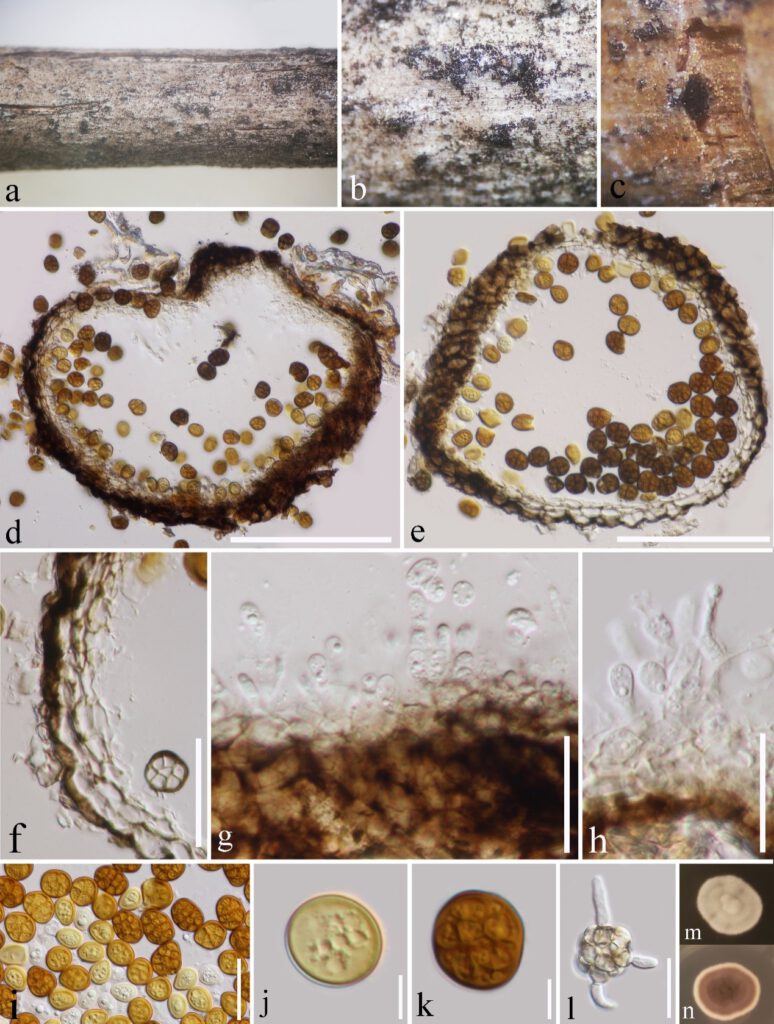Ageratinicola kunmingensis Lu L, K.D. Hyde & Tibpromma S., sp. nov. (Fig. xx)
MycoBank number: MB; Index Fungorum number: IF; Facesoffungi number: FoF 10845;
Etymology: based on the location where fungus was collected.
Saprobic on dead stem of Ageratina adenophora (Spreng.) King & H.Rob. Sexual morph: Undetermined. Asexual morph: Coelomycetous. Conidiomata 100–240 × 90–180 μm (x̅ = 180 × 140 µm, n = 10), pycnidial, globose to subglobose, or irregular, immersed, ostiolate, with a short neck, black. Pycnidial walls 10–16 μm, with 2–4 layers of brown to hyaline cells of textura angularis. Conidiophores reduced to conidiogenous cells. Conidiogenous cells 3.7–5 × 3–3.7 μm (x̅ = 4 × 3 µm, n = 10), enteroblastic, cylindrical, hyaline. Conidia 8–17 × 6–14 μm (x̅ = 12 × 10 µm, n = 20), oval to ellipsoid, or ovoid, muriform, hyaline when young, become pale yellow to brown when maturity, 4–10 septa at maturity.
Culture characteristics: Colonies on PDA reaching 15 mm diam. after 4 weeks in room temperature, at 20 °C, flat, slightly raised, circular, smooth, dense, front gray with white aerial mycelia at margin; reverse sunken, from the inside to the outside, dark gray, dark brown to white, not produced pigments in culture.
Specimen examined: CHINA, Yunnan Province, Kunming, Chang chong mountain, on dead stem of Ageratina adenophora (Spreng.) King & H.Rob (Asteraceae), 20 June 2021. Li Lu, CCS 18, (HKAS 122688, holotype), ex-type culture KUMCC 21–0217.
Hosts and distribution: China, on dead stem of Ageratina adenophora (in this study)
GenBank accession numbers: ITS = xxxxxx, LSU = xxxxxxx, SSU = xxxxxxx
Notes: In the combined ITS, LSU, and SSU gene analysis (Fig xx) showed that, our collection (HKAS 122688, KUMCC 21–0217) forms a distinct clade in Coniothyriaceae which basal to Foliophoma with strong bootstrap support (ML/BI=97/0.99). The base pair differences of ITS, LSU and SSU gene sequences among our collections and the type species of Foliophoma, F. fallens (CBS 161.78, ex-type strain) revealed that 30/574 in ITS, 6/854 bp in LSU. Besides, our isolate morphological characteristics are also very different from Foliophoma by bigger and multi-septate conidia (Hyde et al. 2020). Therefore, we introduce our collection as new species as Ageratinicola kunmingensis.

Fig.1. Ageratinicola kunmingensis (HKAS 122688 holotype). a Examined material. b-c Close view of conidiomata. d-e Cross sections of conidiomata. f Pycnidial wall. g-h Conidia attached to conidiogenous cells. i-k Conidia. l Germinating conidium. m-n Culture on PDA from surface and reverse. Scale bars: d = 100 µm, e = 80 µm, f-i = 20 µm, j-k = 5 µm, l = 20 µm.
